The Jewel Wasp
Biology 342 Fall 2010
Briana Patton and Lisa Schomaker
Host Behavior
Prolonged Grooming
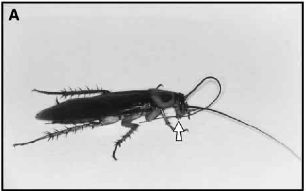
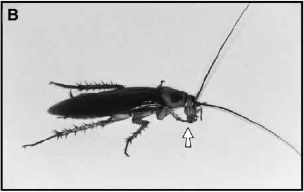
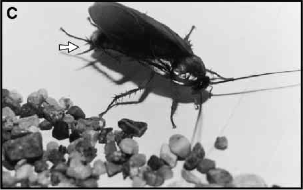
Figure 5. Grooming behavior in a stung Periplaneta americana. From left to right, the photographs depict antennae cleaning, grooming of the foreleg, and cleaning the cercus with a hindleg (Weisel-Eischler et al. 1999).
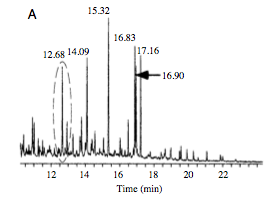 The sting into the cerebral ganglia elicits a specific set of behaviors from the cockroach ( see figure 5). Almost immediately following the sting, the cockroach begins engaging in grooming behaviors which continue for approximately 30 minutes, during which the wasp leaves the cockroach to search for a suitable burrow. (Weisel-Eischler et al. 1999). This prolonged grooming session is likely due to activation of a central grooming circuit by a dopamine like component of the venom. Mass spectroscopy of sub protein fractions of the venom confirmed the presence of a monoamine component that most closely resembles dopamine or octopamine. Certain behaviors like grooming have a central neural circuit, which when activated by electrical or chemical stimulation produce the behavior. When injected with flupentixol, a dopamine receptor antagonist, prior to encountering a wasp, cockroaches displayed significantly reduced grooming behavior. Treatment with octopamine antagonists failed to block prolonged grooming. It is unknown if the prolonged grooming behavior has any adaptive value aside from preventing the cockroach from escaping . (Figure 6. Gas chromatography of jewel wasp venom revealed six major components. The circled peak at 12.68 minutes is likely dopamine. From Weisel-Eischler et al. 1999.)
The sting into the cerebral ganglia elicits a specific set of behaviors from the cockroach ( see figure 5). Almost immediately following the sting, the cockroach begins engaging in grooming behaviors which continue for approximately 30 minutes, during which the wasp leaves the cockroach to search for a suitable burrow. (Weisel-Eischler et al. 1999). This prolonged grooming session is likely due to activation of a central grooming circuit by a dopamine like component of the venom. Mass spectroscopy of sub protein fractions of the venom confirmed the presence of a monoamine component that most closely resembles dopamine or octopamine. Certain behaviors like grooming have a central neural circuit, which when activated by electrical or chemical stimulation produce the behavior. When injected with flupentixol, a dopamine receptor antagonist, prior to encountering a wasp, cockroaches displayed significantly reduced grooming behavior. Treatment with octopamine antagonists failed to block prolonged grooming. It is unknown if the prolonged grooming behavior has any adaptive value aside from preventing the cockroach from escaping . (Figure 6. Gas chromatography of jewel wasp venom revealed six major components. The circled peak at 12.68 minutes is likely dopamine. From Weisel-Eischler et al. 1999.)
Hypokinesis
Following the period of grooming, the cockroach enters a hypokinetic state that “is characterized by little spontaneous or provoked activty”(Libersat F. et al. 2009). The cockroach is capable of movement, but generally appears reluctant to engage in any activity unless provoked or directed. Interestingly, while the cockroach is in the hypokinetic state, some stimuli will still induce the appropriate responses while others will not. Hypokinetic cockroaches will still swim when placed under water, right them selves, and fly in a wind tunnel, but fail to respond to stimuli that usually generate escape responses.
Octopamine-based neuronal control
Hypokinesis is likely achieved through modulation of firing in octapiminergic neurons (neurons which produce the monoamine octopamine), though it is unknown what component of the venom might be responsible for this effect. Octopamine is often associated with initation of motor function in many invertebrates (Libersat F. et al. 2004). Consistent with this theory, hypokinetic cockroach exhibit dramatic decreased firing rates in octopaminergic neurons (Rosenberg L. et al. 2006). Injecting hypokinetic cockroaches with chlordimeform, an octopamine receptor agonist, produced an increase in spontaneous walking while injecting control cockroaches with octopamine receptor antagonists decreased walking activity, mimicking hypokinesis (Rosenberg L. et al. 2007).
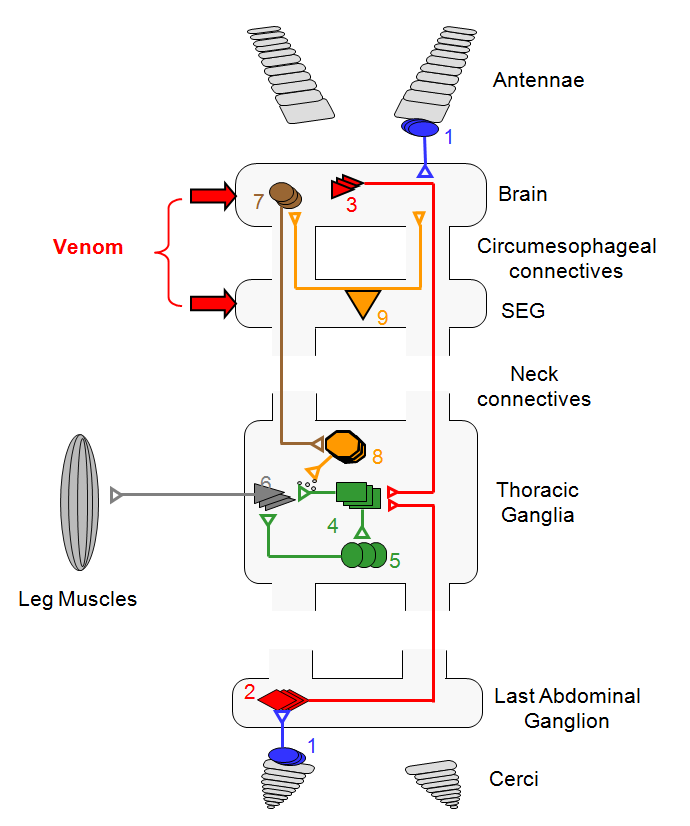 Understanding octopamine's importance in repressing walking is key to formulating a model of the neuronal events behind hypokinesis (see figure 7). A cluster of octopaminergic neurons called the dorsal unpaired median (DUM) neurons are located within the SEG, one of the venom injection sites. The DUM project to neurons in the brain which in turn project to neurons in the thoracic ganglia that influence motor neurons. Injecting venom into the SEG knocks out the octopamine production in the DUM neurons. Decreased levels of octopamine suppresses activity in the cerebral neurons that project to thoracic motor neurons, effectively preventing any stimuli received by head ganglia from eliciting motor reactions. Stimuli received by neurons not associated with the DUM can still produce movement (Libersat F. et al. 2009). Targeting these circuits leaves the cockroach able to initate and maintain movement when directed by the wasp, but unable to do so spontaneously. Hypokinesis not only facilitates the wasp's control of the cockroach's movement prior to implantation of the larvae, but also slows the cockroach's metabolic rate, allowing it to live longer on fewer resources. Once the cockroach has been buried with the wasp larvae, it expends almost no energy to stay alive, thus preserving its nutritional value for the larvae when it pupates. (Figure 7. Model of the neurophysiological events leading to hypokinesis. from Libersat F. et al. 2009)
Understanding octopamine's importance in repressing walking is key to formulating a model of the neuronal events behind hypokinesis (see figure 7). A cluster of octopaminergic neurons called the dorsal unpaired median (DUM) neurons are located within the SEG, one of the venom injection sites. The DUM project to neurons in the brain which in turn project to neurons in the thoracic ganglia that influence motor neurons. Injecting venom into the SEG knocks out the octopamine production in the DUM neurons. Decreased levels of octopamine suppresses activity in the cerebral neurons that project to thoracic motor neurons, effectively preventing any stimuli received by head ganglia from eliciting motor reactions. Stimuli received by neurons not associated with the DUM can still produce movement (Libersat F. et al. 2009). Targeting these circuits leaves the cockroach able to initate and maintain movement when directed by the wasp, but unable to do so spontaneously. Hypokinesis not only facilitates the wasp's control of the cockroach's movement prior to implantation of the larvae, but also slows the cockroach's metabolic rate, allowing it to live longer on fewer resources. Once the cockroach has been buried with the wasp larvae, it expends almost no energy to stay alive, thus preserving its nutritional value for the larvae when it pupates. (Figure 7. Model of the neurophysiological events leading to hypokinesis. from Libersat F. et al. 2009)
Visual References
Video 1: Exoparacitism overview
Video 2: Emergence of mature wasp